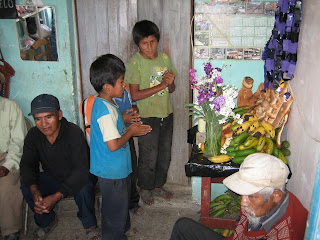

In the evening, Sister Helena and her nephew Sean came from Coroico to have dinner with Sister Jean, Sister Carmen and myself. Dessert was King Kong, a special cake that Carmen brought from Peru.






















 Photo: The Committee! (front, L to R) Academic Secretary Manuela Urbina, Religious Ed Coordinator Sister Jean Morrissey, Coroico Bishop Juan Vargas, Franciscan Sister Maureen Coyle, (back) Advisor and former Bolivian Embassador to the U.S. Jorge Crespo, College Director Father Freddy del Villar, Carmen Pampa Fund Director John Estrem, College Vice Director of the College Hugh Smeltekop, Carmen Pampa Fund Liaison Sarah Mechtenberg, former Carmen Pampa Fund Director Sue Wheeler, College Education Department Director Andrés Pardo and co-founder of the College Ann Leahy.
Photo: The Committee! (front, L to R) Academic Secretary Manuela Urbina, Religious Ed Coordinator Sister Jean Morrissey, Coroico Bishop Juan Vargas, Franciscan Sister Maureen Coyle, (back) Advisor and former Bolivian Embassador to the U.S. Jorge Crespo, College Director Father Freddy del Villar, Carmen Pampa Fund Director John Estrem, College Vice Director of the College Hugh Smeltekop, Carmen Pampa Fund Liaison Sarah Mechtenberg, former Carmen Pampa Fund Director Sue Wheeler, College Education Department Director Andrés Pardo and co-founder of the College Ann Leahy.

...Be praised, my Lord, through all your creatures,
especially through my lord Brother Sun,
who brings the day; and you give light through him.
And he is beautiful and radiant in all his splendor!
Of you, Most High, he bears the likeness.
Be praised, my Lord, through Sister Moon and the stars;
in the heavens you have made them bright, precious and beautiful.
...
Be praised, my Lord, through our Sister Bodily Death,
from whose embrace no living person can escape.
Woe to those who die in mortal sin!
Happy those she finds doing your most holy will.
The second death can do no harm to them.
Praise and bless my Lord, and give thanks,
and serve him with great humility.





















